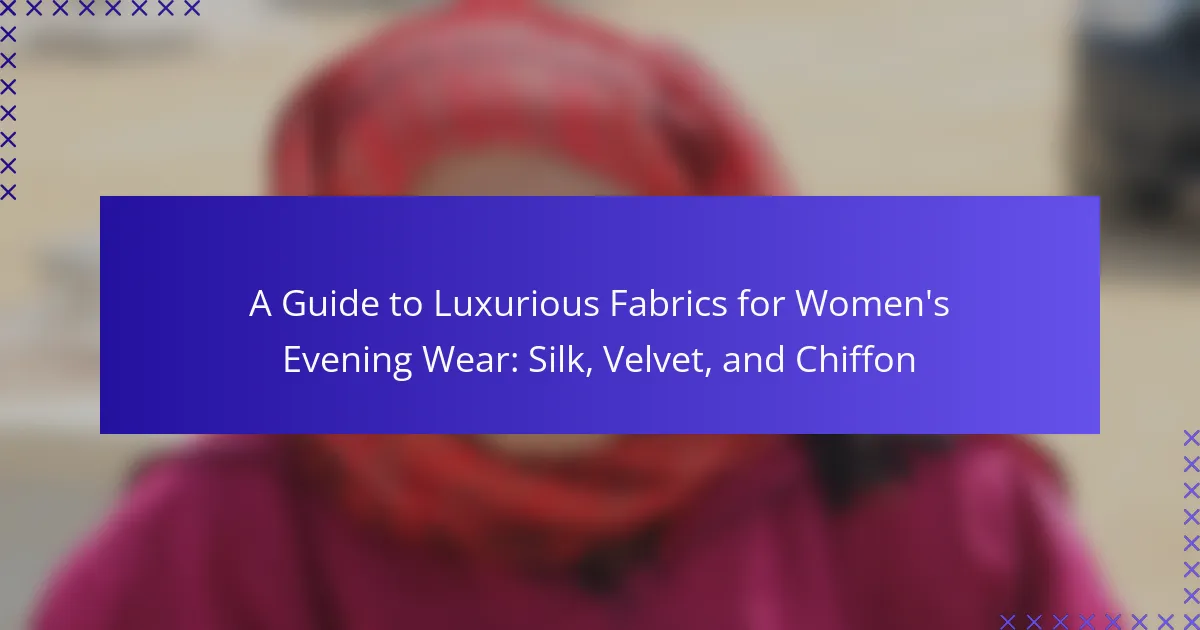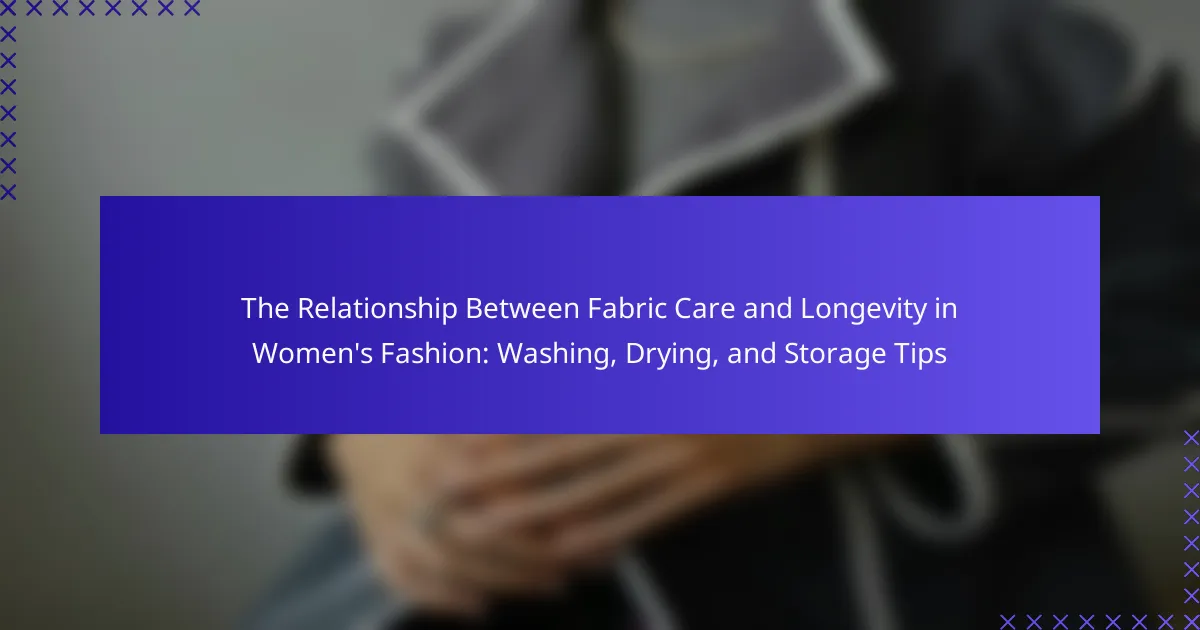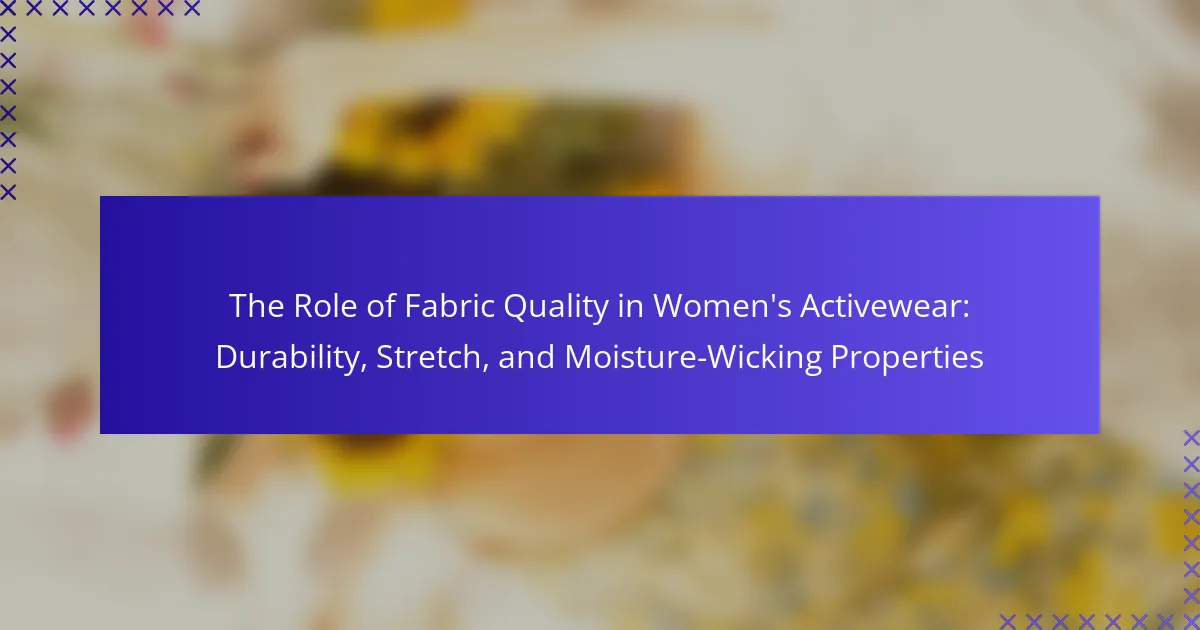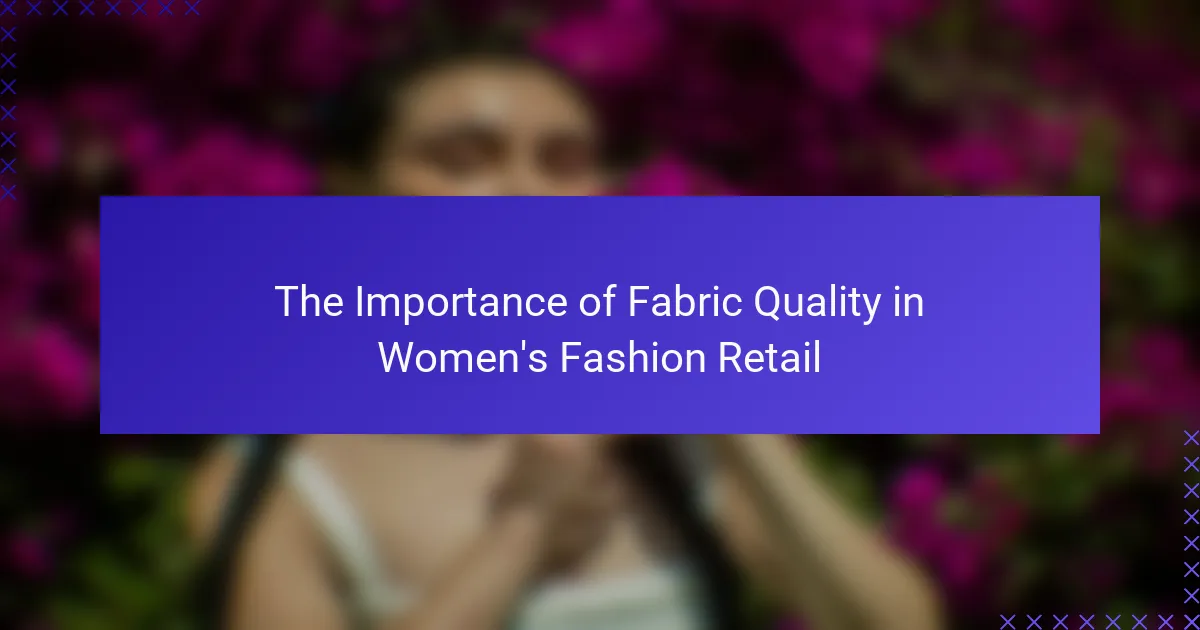This article provides a comprehensive guide to luxurious fabrics used in women’s evening wear, specifically focusing on silk, velvet, and chiffon. Silk is characterized by its smooth texture and elegant drape, making it a popular choice for high-end dresses. Velvet offers a rich, plush feel and is favored for its opulent appearance, while chiffon is lightweight and sheer, often used for layering in formal attire. The article also explores various types of each fabric, their suitability for different styles and occasions, and considerations for selecting the right fabric based on gown silhouette, color, and comfort.
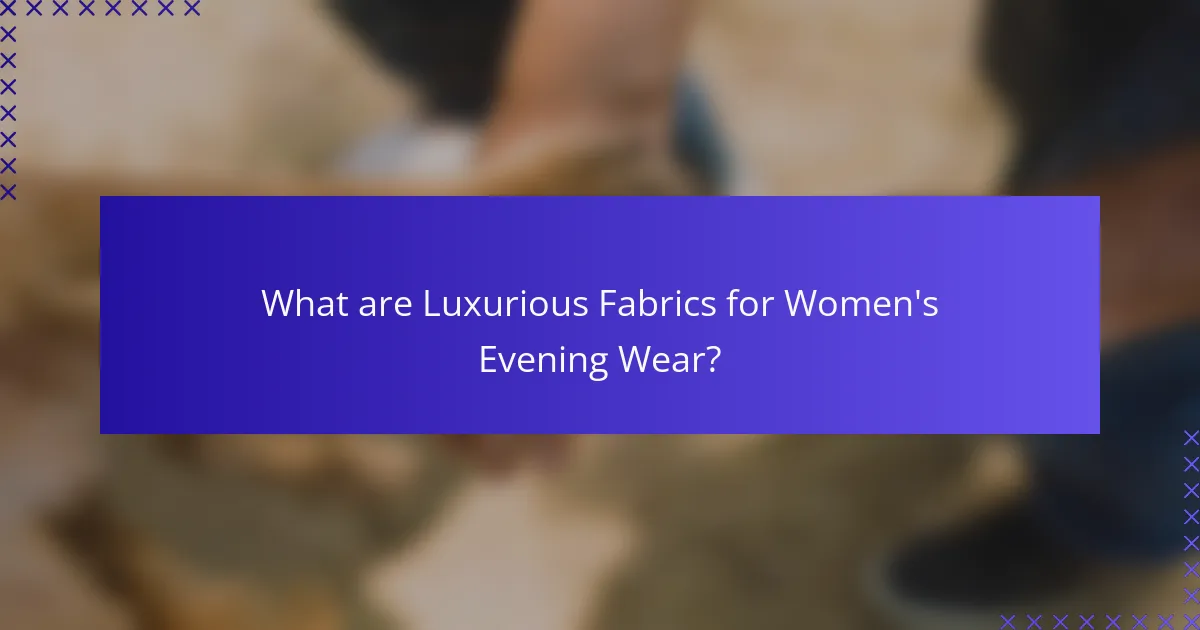
What are Luxurious Fabrics for Women’s Evening Wear?
Luxurious fabrics for women’s evening wear include silk, velvet, and chiffon. Silk is known for its smooth texture and elegant drape. It is often used in high-end dresses and gowns. Velvet offers a rich, plush feel and a luxurious appearance. This fabric is popular for evening wear due to its opulence. Chiffon is lightweight and sheer, providing a delicate look. It is frequently layered or used as an overlay in formal attire. Each of these fabrics enhances the overall aesthetic of evening wear, contributing to a sophisticated style.
Why are Silk, Velvet, and Chiffon considered luxurious fabrics?
Silk, Velvet, and Chiffon are considered luxurious fabrics due to their unique textures and origins. Silk is prized for its smoothness and sheen, derived from silkworms. Velvet features a rich, soft pile that creates depth and warmth, made from silk or cotton fibers. Chiffon is lightweight and airy, often made from silk, which adds elegance to garments. These fabrics are associated with high quality and exclusivity. Historical significance also contributes to their luxury status, as silk was once a symbol of wealth in ancient cultures. The craftsmanship involved in producing these fabrics further enhances their luxurious appeal.
What are the unique characteristics of Silk?
Silk is a luxurious fabric known for its unique luster and softness. It is produced by silkworms, primarily the Bombyx mori species. Silk has a natural sheen that reflects light beautifully, enhancing its aesthetic appeal. The fabric is lightweight yet strong, providing a comfortable wear. Additionally, silk has excellent draping qualities, making it ideal for elegant evening wear. It is also hypoallergenic, making it suitable for sensitive skin. Furthermore, silk has moisture-wicking properties, keeping the wearer cool and dry. Its ability to retain dye allows for vibrant colors and intricate patterns. These characteristics make silk a sought-after choice for high-end fashion.
How does Velvet differ from other fabrics?
Velvet differs from other fabrics primarily due to its unique texture and construction. It is characterized by a soft, plush surface created by cutting the fibers of the fabric, resulting in a rich, luxurious feel. Unlike standard woven fabrics, velvet typically has a thicker pile, which gives it depth and a distinctive appearance. This fabric is often made from silk, cotton, or synthetic fibers, enhancing its versatility. Additionally, velvet has a unique ability to reflect light differently, creating a shimmering effect that adds elegance to evening wear. Its heavy weight also contributes to its drape and structure, setting it apart from lighter fabrics like chiffon. Velvet is often used in high-end fashion, particularly for formal occasions, due to its opulent qualities.
What makes Chiffon a popular choice for evening wear?
Chiffon is a popular choice for evening wear due to its lightweight and airy texture. This fabric drapes beautifully, creating an elegant silhouette. Chiffon offers a soft and romantic appearance, enhancing the overall aesthetic of evening gowns. Its sheer quality allows for layering and can add depth to designs. Chiffon is also versatile, suitable for various styles and occasions. Additionally, it comes in a wide range of colors, catering to diverse fashion preferences. The fabric’s ability to flow gracefully contributes to its appeal in formal settings. These attributes collectively make chiffon a favored option for evening attire.
How do these fabrics enhance women’s evening wear?
Silk, velvet, and chiffon enhance women’s evening wear by adding elegance and sophistication. Silk provides a luxurious sheen and smooth texture, making garments feel premium. Velvet adds depth and richness, creating a plush appearance that elevates any outfit. Chiffon contributes a light, airy quality, allowing for graceful movement and layering. These fabrics also drape beautifully, enhancing the overall silhouette. Their unique textures and finishes create visual interest, making evening wear more appealing. Additionally, these materials are often associated with formal occasions, reinforcing the attire’s appropriateness for special events.
What aesthetic appeal do Silk, Velvet, and Chiffon bring to evening gowns?
Silk, Velvet, and Chiffon enhance evening gowns with their unique textures and visual appeal. Silk offers a luxurious sheen and smooth drape, creating an elegant silhouette. Velvet adds depth and richness with its soft, plush surface, making gowns look opulent. Chiffon contributes a light, airy quality, allowing for graceful movement and layering. Each fabric reflects light differently, enhancing the overall aesthetic. Together, they provide versatility in design, from structured to flowing styles. The combination of these fabrics elevates evening wear, making it suitable for formal occasions. Their popularity in haute couture further validates their aesthetic significance in fashion.
How do these fabrics contribute to comfort during events?
Silk, velvet, and chiffon enhance comfort during events through their unique properties. Silk is smooth and breathable, allowing for temperature regulation. This helps to keep the wearer cool in warm conditions. Velvet offers a plush texture that feels soft against the skin. Its weight provides a sense of warmth without being overly heavy. Chiffon is lightweight and airy, promoting ease of movement. This fabric drapes beautifully, reducing restrictions during activities. Together, these fabrics create a luxurious experience that prioritizes comfort for the wearer.
What are the care and maintenance tips for these luxurious fabrics?
Silk, velvet, and chiffon require specific care and maintenance to preserve their luxurious qualities. For silk, hand wash in cold water with a mild detergent. Avoid wringing or twisting the fabric to prevent damage. Velvet should be spot cleaned with a damp cloth and can be steamed to remove wrinkles. Do not machine wash velvet, as it can lose its texture. Chiffon is best washed by hand in cold water and air-dried to maintain its delicate nature. Always store these fabrics in a cool, dry place to prevent mildew and damage.
How should Silk garments be cleaned and stored?
Silk garments should be cleaned gently, preferably by hand washing in cold water with a mild detergent. Avoid wringing or twisting the fabric, as this can damage the fibers. Instead, lay the garment flat on a clean towel to absorb excess water. For storage, silk should be kept in a cool, dry place away from direct sunlight. Use breathable garment bags to protect against dust and pests. Avoid hanging silk garments for extended periods, as this can lead to stretching. Proper care ensures silk maintains its luxurious appearance and longevity.
What are the best practices for maintaining Velvet’s texture?
To maintain velvet’s texture, avoid excessive moisture and heat. Velvet should be stored in a cool, dry place. Use a garment bag to protect it from dust and sunlight. When cleaning, opt for dry cleaning to preserve its texture. If washing at home, use a gentle cycle with cold water. Avoid wringing or twisting the fabric to prevent damage. Iron velvet on a low setting or use a steamer from a distance. Regularly brush the fabric with a soft brush to keep the pile looking fresh. These practices help retain the luxurious feel of velvet over time.
How can one care for Chiffon to prolong its life?
To care for chiffon and prolong its life, hand wash it in cold water. Use a mild detergent specifically designed for delicate fabrics. Avoid wringing or twisting the fabric to prevent damage. Instead, gently squeeze out excess water and lay it flat to dry. Iron chiffon on a low heat setting, preferably while it is slightly damp. Always use a pressing cloth to protect the fabric from direct heat. Store chiffon garments in a cool, dry place, ideally hanging to avoid creasing. Avoid exposure to direct sunlight to prevent fading. Following these steps helps maintain chiffon’s delicate texture and appearance.
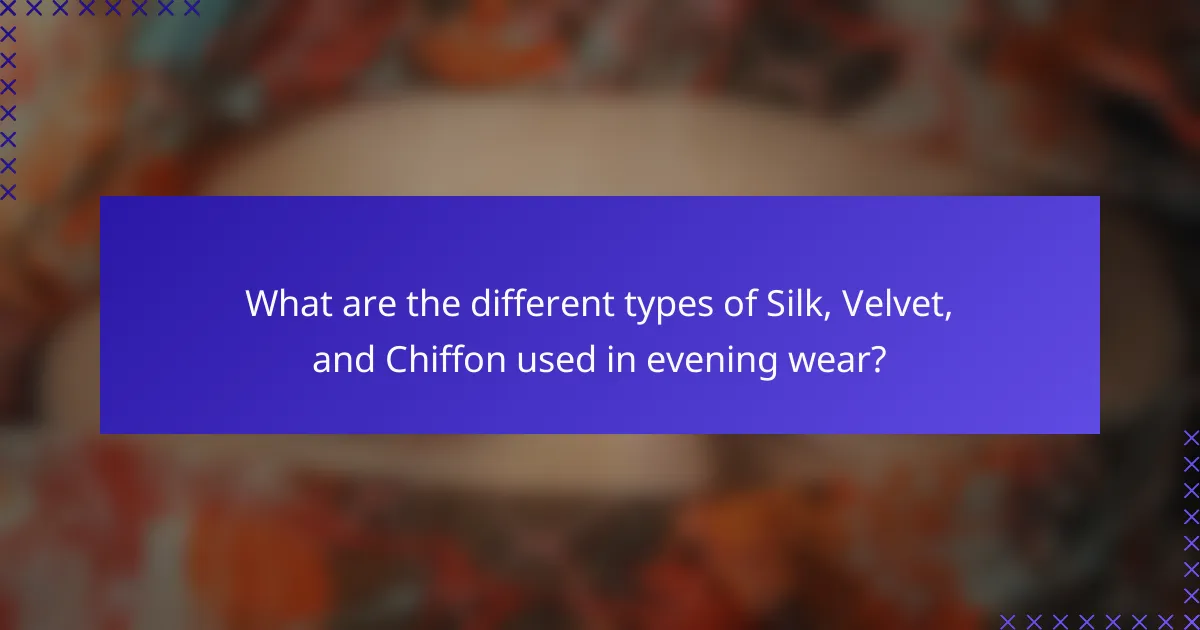
What are the different types of Silk, Velvet, and Chiffon used in evening wear?
Silk, velvet, and chiffon each have various types used in evening wear. Silk types include charmeuse, chiffon, and taffeta. Charmeuse is known for its luxurious shine and soft drape. Chiffon silk is lightweight and sheer, ideal for layering. Taffeta silk has a crisp texture and structure.
Velvet types used in evening wear include crushed velvet, stretch velvet, and silk velvet. Crushed velvet has a textured appearance, adding depth to garments. Stretch velvet provides flexibility and comfort, making it suitable for fitted designs. Silk velvet offers a rich feel and elegant finish.
Chiffon types include silk chiffon, polyester chiffon, and georgette. Silk chiffon is soft and flowing, perfect for evening gowns. Polyester chiffon is more durable and affordable, often used in various styles. Georgette is a heavier version, providing more structure while maintaining a light feel.
What are the various types of Silk available for evening wear?
The various types of silk available for evening wear include charmeuse, chiffon, satin, and taffeta. Charmeuse silk is known for its luxurious sheen and soft drape, making it ideal for elegant dresses. Chiffon silk is lightweight and sheer, often used for layering and flowing designs. Satin silk has a glossy surface and a smooth texture, perfect for structured garments. Taffeta silk is crisp and holds its shape well, suitable for formal silhouettes. Each type of silk offers unique qualities that enhance evening wear.
How does each type of Silk differ in appearance and feel?
Silk types differ significantly in appearance and feel. Mulberry silk is smooth and lustrous, known for its uniform texture. Tussah silk has a more textured feel and a natural gold color. Habotai silk is lightweight and soft, offering a delicate drape. Charmeuse silk is glossy on one side and matte on the other, providing a luxurious touch. Each type’s unique fiber structure affects its overall look and tactile experience. Mulberry silk is often considered the finest due to its long fibers. Tussah silk’s coarser texture makes it less shiny but more durable. Habotai silk is commonly used for linings due to its softness. Charmeuse silk is favored for evening wear because of its elegant sheen.
Which type of Silk is best suited for formal occasions?
The best type of silk suited for formal occasions is silk satin. Silk satin has a smooth, glossy finish that adds elegance to evening wear. This fabric drapes beautifully, enhancing the silhouette of formal dresses. Its luxurious texture feels comfortable against the skin. Additionally, silk satin is known for its vibrant color retention and durability. Many designers prefer silk satin for evening gowns and formal attire. This preference is due to its ability to create a polished and sophisticated look.
What types of Velvet are commonly used in evening wear?
The types of velvet commonly used in evening wear include crushed velvet, silk velvet, and cotton velvet. Crushed velvet has a textured appearance and is often used for its luxurious look. Silk velvet is known for its softness and sheen, making it a popular choice for formal attire. Cotton velvet, while less glossy, offers a rich texture and is durable, suitable for various evening garments. These velvets are favored for their aesthetic appeal and comfort in evening wear.
What are the differences between crushed velvet and smooth velvet?
Crushed velvet and smooth velvet differ primarily in texture and appearance. Crushed velvet has a distinctive, uneven surface created by crushing the fabric during production. This gives it a rich, textured look that reflects light differently. Smooth velvet features a consistent, soft surface with a uniform pile. The finish of smooth velvet is sleek and luxurious, ideal for elegant garments. Crushed velvet is often used for statement pieces, while smooth velvet is favored for classic evening wear. The unique processing of crushed velvet results in a more dramatic aesthetic compared to the subtle elegance of smooth velvet.
How does the weight of Velvet affect its use in evening gowns?
The weight of velvet significantly influences its use in evening gowns. Heavier velvet provides a luxurious drape and structure. This weight enhances the gown’s silhouette and creates an elegant appearance. Lighter velvet, while still luxurious, may not offer the same level of structure. It tends to flow more freely, resulting in a softer look. The weight also affects comfort; heavier fabrics can be warmer, making them suitable for cooler events. Conversely, lighter velvet is more breathable, ideal for warmer climates. Designers often choose velvet weight based on the desired style and occasion. The choice impacts not only aesthetics but also functionality and wearability.
What are the different types of Chiffon fabrics?
There are several types of chiffon fabrics, each with distinct characteristics. The most common types include silk chiffon, polyester chiffon, and nylon chiffon. Silk chiffon is known for its luxurious feel and lightweight nature. Polyester chiffon offers durability and is often more affordable. Nylon chiffon is typically more elastic and resistant to wrinkles. Other variations include rayon chiffon and cotton chiffon, which provide different textures and uses. Each type of chiffon fabric has unique attributes suited for various fashion applications.
How do the weights of Chiffon influence its drape and use?
The weights of chiffon significantly influence its drape and use. Lightweight chiffon offers a soft, flowing drape, making it ideal for delicate garments like evening gowns and scarves. Heavier chiffon provides more structure, suitable for tailored pieces and layered designs. The weight affects how the fabric falls and moves, impacting overall aesthetics. For example, lighter chiffon creates ethereal looks, while heavier options can enhance shape and form. This versatility allows designers to choose chiffon based on desired style and function.
What qualities should one look for in high-quality Chiffon?
High-quality chiffon should be lightweight, breathable, and have a soft texture. It typically features a slightly crinkled surface that adds depth. The fabric should have a smooth drape, allowing it to flow gracefully. Additionally, high-quality chiffon is often made from silk or a silk blend, enhancing its luxurious feel. The color should be vibrant and consistent throughout the fabric. Lastly, it should be durable, resisting fraying and wear over time. These characteristics ensure that chiffon maintains its elegance and usability for evening wear.
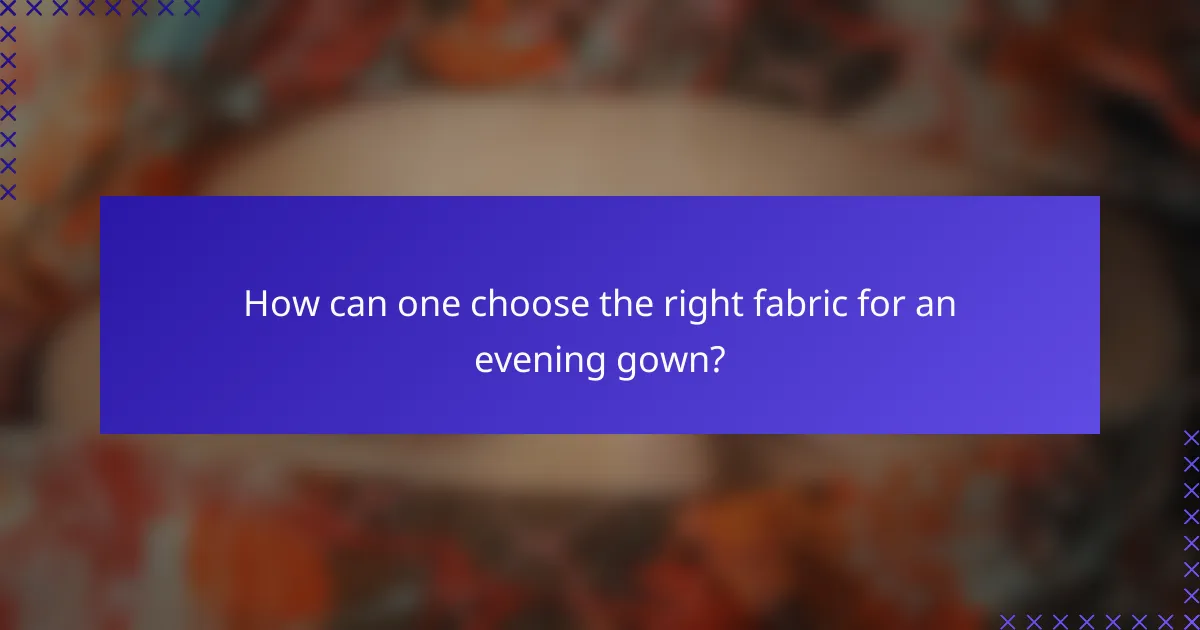
How can one choose the right fabric for an evening gown?
To choose the right fabric for an evening gown, consider the gown’s intended style and occasion. Fabrics like silk offer elegance and a luxurious feel. Velvet provides a rich texture and warmth, suitable for colder events. Chiffon is lightweight and flowing, ideal for warmer settings. Assess the gown’s silhouette, as structured designs may benefit from stiffer fabrics. For a more relaxed look, opt for softer materials. Additionally, consider the gown’s color and print, as certain fabrics enhance specific hues. Finally, factor in comfort and movement, ensuring the fabric allows for ease of wear.
What factors should be considered when selecting a fabric for evening wear?
When selecting a fabric for evening wear, consider the fabric’s drape, texture, and sheen. Drape affects how the fabric falls on the body. Fabrics like silk and chiffon have a fluid drape, enhancing elegance. Texture impacts comfort and visual appeal. Velvet offers a rich texture, while chiffon is lightweight and airy. Sheen contributes to the overall glamour. Fabrics with a high sheen, like satin, reflect light beautifully. Additionally, consider the season and occasion. Heavier fabrics suit winter events, while lighter fabrics are ideal for summer. The fabric’s durability is also important for long-lasting wear.
How does the event type influence fabric choice?
The event type significantly influences fabric choice for women’s evening wear. Formal events typically require luxurious fabrics like silk and velvet. These materials convey elegance and sophistication, aligning with the expectations of upscale gatherings. For less formal occasions, lighter fabrics like chiffon may be preferred. Chiffon offers a flowy, comfortable feel suitable for casual yet chic events. The season also plays a role; heavier fabrics are favored in winter, while lighter options are better for summer. Choosing the right fabric enhances the overall aesthetic and appropriateness for the specific event.
What role does personal style play in fabric selection?
Personal style significantly influences fabric selection. Individuals choose fabrics that reflect their personality and aesthetic preferences. For example, someone with a romantic style may prefer soft, flowing chiffon. In contrast, a bold personality might opt for structured velvet. The texture and drape of fabrics align with personal style choices. Additionally, color preferences tied to personal style further guide fabric selection. Ultimately, fabric choice enhances the overall expression of one’s unique fashion identity.
What are some styling tips for wearing Silk, Velvet, and Chiffon evening wear?
Silk, Velvet, and Chiffon evening wear requires specific styling tips for optimal presentation. Choose elegant silhouettes that complement the fabric’s natural drape. For silk, opt for fitted designs to highlight its sheen. Velvet looks best in structured forms, enhancing its rich texture. Chiffon benefits from layered styles that create movement. Pair silk with minimal accessories to maintain sophistication. Velvet pairs well with bold jewelry for a striking contrast. Chiffon can be styled with delicate pieces to enhance its softness. Always consider color coordination to ensure harmony in your outfit.
How can accessories enhance the look of these luxurious fabrics?
Accessories can enhance the look of luxurious fabrics like silk, velvet, and chiffon by adding texture and contrast. For instance, a statement necklace can draw attention to the neckline of a silk dress. Bold earrings can complement the rich tones of velvet, creating a striking visual impact. A delicate scarf can add elegance to chiffon, enhancing its flow and movement. Accessories also allow for personal expression, making the outfit unique. The right handbag can provide a polished finish, tying the entire look together. Accessories can elevate simple fabrics, making them suitable for formal occasions. Overall, they play a crucial role in styling luxurious fabrics.
What are some common color combinations that work well with these fabrics?
Silk, velvet, and chiffon fabrics pair well with various color combinations. For silk, rich jewel tones like emerald green and royal blue create an elegant contrast. Velvet works beautifully with deep colors such as burgundy and navy, enhancing its luxurious texture. Chiffon complements pastel shades like blush pink and lavender, adding a soft, romantic touch. These combinations are commonly used in evening wear to create visually appealing outfits. Fashion designers often utilize these pairings to evoke sophistication and style in their collections.
What are the latest trends in evening wear fabrics?
The latest trends in evening wear fabrics include the use of sustainable materials, bold colors, and innovative textures. Sustainable fabrics, such as organic silk and recycled polyester, are gaining popularity due to environmental concerns. Bold colors like deep emerald and rich burgundy are trending, moving away from traditional black. Innovative textures, including pleated and layered designs, add depth to evening wear. Additionally, metallic fabrics are being embraced for their eye-catching appeal. Designers are also incorporating lace and sheer elements to create a modern, sophisticated look. These trends reflect a shift towards both elegance and sustainability in evening wear fashion.
How are designers innovating with Silk, Velvet, and Chiffon?
Designers are innovating with silk, velvet, and chiffon by incorporating sustainable practices and advanced technology. They are using eco-friendly dyes and organic materials to minimize environmental impact. Additionally, designers are experimenting with smart textiles that respond to temperature and light. This enhances comfort and functionality in evening wear. Techniques like digital printing allow for intricate patterns and designs on these fabrics. Furthermore, designers are blending these materials to create unique textures and styles. Innovations in weaving techniques also contribute to the versatility of these fabrics. These advancements reflect a commitment to both aesthetics and sustainability in fashion.
What new fabric blends are emerging in evening wear fashion?
New fabric blends emerging in evening wear fashion include silk and cashmere, as well as silk and tulle. These blends offer enhanced softness and drape. Silk-cashmere blends provide warmth without bulk. Silk-tulle combinations create ethereal looks suitable for formal occasions. Additionally, blends like velvet with spandex are gaining popularity. They offer stretch and comfort while maintaining a luxurious appearance. Recent fashion shows have showcased these innovative blends, indicating a trend towards versatility and elegance in evening wear.
What are the best practices for shopping for luxurious fabrics?
When shopping for luxurious fabrics, prioritize quality over price. Inspect the fabric’s texture, weight, and sheen. High-quality silk feels smooth and has a natural luster. Velvet should have a rich, dense pile and a soft touch. Chiffon must be lightweight and slightly sheer. Always check the fabric’s drape by holding it up to see how it flows. Look for reputable retailers known for luxury fabrics. Additionally, understand the care requirements of each fabric type. This knowledge will ensure longevity and maintain the fabric’s luxurious appearance.
How can one identify quality fabrics when shopping?
To identify quality fabrics when shopping, examine the material’s texture and feel. High-quality fabrics should feel smooth and luxurious against the skin. Look for fabrics that have a weighty drape, indicating they are well-made. Check for consistent color and pattern throughout the fabric. Inspect the stitching; quality fabrics will have neat, even seams without loose threads. Perform a burn test if possible; natural fibers like silk and cotton will burn cleanly, while synthetic fibers may melt. Lastly, consider the brand reputation; established brands often maintain higher quality standards.
What are the advantages of purchasing from reputable brands or boutiques?
Purchasing from reputable brands or boutiques ensures higher quality products. Reputable brands maintain strict quality control standards. This often results in superior craftsmanship and materials. For instance, silk from established brands typically has a finer weave and better durability.
Additionally, reputable brands offer better customer service and support. They often provide clear return policies and warranties. This enhances the shopping experience and builds customer trust. Buying from these brands can also signify status and exclusivity.
Statistically, consumers report higher satisfaction rates when buying from well-known brands. According to a study by Nielsen, 60% of consumers prefer to purchase from brands they recognize. This preference highlights the perceived value associated with reputable brands.
The main entity of the article is luxurious fabrics for women’s evening wear, specifically focusing on silk, velvet, and chiffon. The article provides a comprehensive overview of these fabrics, detailing their unique characteristics, aesthetic appeal, and contributions to comfort in evening gowns. It explores the various types of each fabric, care and maintenance tips, and factors influencing fabric selection based on event type and personal style. Additionally, the article discusses current trends and innovations in evening wear fabrics, emphasizing the importance of quality when shopping for these luxurious materials.
